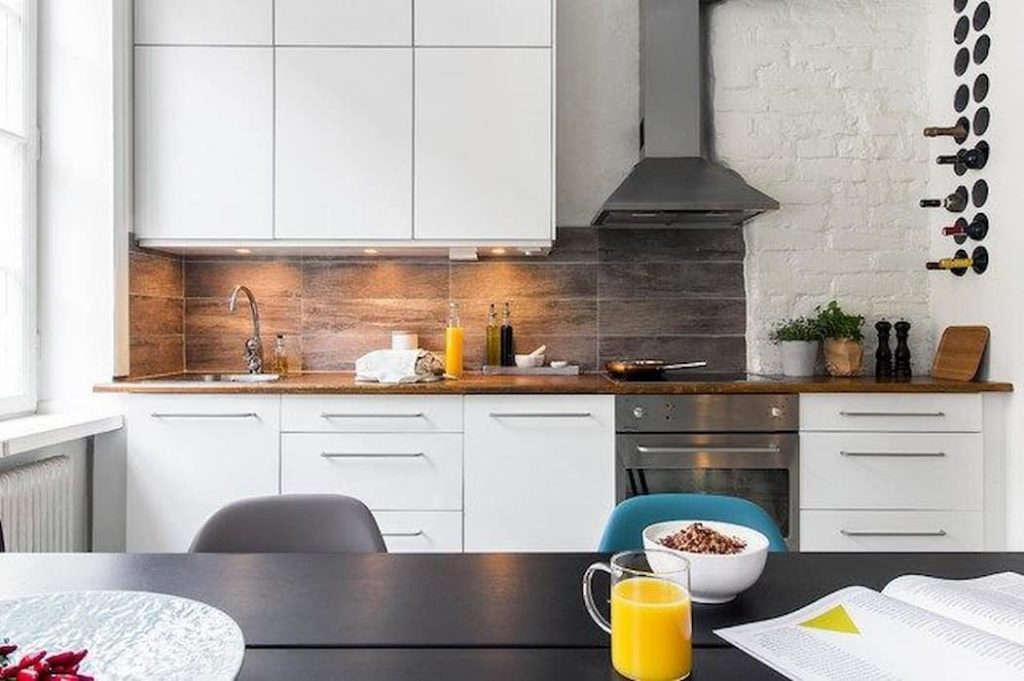There are certainly some cleaning tips you should know in order to maintain excellent hygiene as well as to prevent damage or wear over time in the kitchen floor tiles. The finest tile cleaner and several cleaning techniques are covered in this article.
Which tile cleaner works the best?
Depending on the sort of tile you have, there are several tile cleaners for kitchen and bathroom tiles. Choose the proper tile for the task, since ceramic and porcelain tiles both have quite different cleaning requirements than, say, raw stone.
It also depends on how worried you are about the environment and if you only want to use natural ingredients. Always use a cleanser with a neutral PH, a solution of white vinegar that has been diluted, and orange oil to get the deepest clean.
How can kitchen tiles be cleaned?
Grease will gradually accumulate over time on kitchen tiles, so it’s important to know how to remove it if you’re cleaning the tiled backsplash behind the stove. Most likely, you will need to start by using a degreasing chemical to get rid of any cooking grease and oils that have built up. Follow the degreasing product’s instructions, then wipe down the surfaces with a new, damp cloth and buff them with a dry one.

It is possible to clean kitchen tiles with vinegar, but we advise diluting the solution with at least 50% water since acid can damage some tiles’ surfaces. Use vinegar to remove persistent stains, but quickly rinse the tiles with fresh, clean water to lessen the acidity.
Orange or lemon oil is a fantastic cleaning agent and a natural degreaser. Just a few drops of liquid should be applied directly to the tile’s surface, followed by a clean, moist cloth or sponge to remove the oil and freshen the air in your house.
A nice steam mop for your kitchen floor is also a smart investment. It is effective cleaning for kitchen floor tiles. Most steam mops simply use water, but others allow you to use cleaning solutions as well. If you’d like, you may also add a few drops of vinegar for a more natural cleaning solution. The steam mop removes surface dirt while sterilizing any microorganisms. The finest feature is the replaceable pads, which can be easily washed in the washing machine to keep your mop hygienically clean for a lot longer than a typical damp mop would.
Your choice of tile grout can also significantly affect future cleaning. A darker grout will reveal less stains and discolorations over a longer length of time if it is utilized for a kitchen backsplash or bathroom shower.
Additionally, when the grout has cured, you may use a topical grout protectant, which is often a spray and dries quickly. This will assist you in preventing the accumulation of dirt, oil, and filth and extend the life of your grout. Most steam mops come with different attachments for different parts of your home. This makes them a great way to clean your grout without damaging the protective coating on it.

how to wash tiles made of natural stone
Natural stone is inherently absorbent, so it’s crucial to think about the intended purpose when selecting any sort of stone. Natural stone must be sealed before it can be used to keep it from absorbing water or dirt and getting stained. The standards for sealing depend on the type of stone.
It’s vital to get the right sealer with your tiles because there are several types of sealant based on the type of stone and its finish, such as unpolished vs polished. Once your tiles have been sealed, you must routinely maintain the sealant on the surface since it will eventually wear away. It’s crucial to use the right cleaning chemicals to extend the life of your sealer. Always use a PH-neutral cleanser, a moist cloth, or a steam mop on tile floors.
Whether you need to replace your sealer depends on the type of stone you’ve chosen and the amount of use it receives. For example, does it get used in a busy hallway where there are often muddy footprints? Any kind of stone should be resealed every six months to keep it from getting stained, but it’s best to ask a professional about how to take care of your tiles. Our staff is always happy to help.
Additionally, the Fila care and maintenance range is completely solvent-free and environmentally friendly because it is water-based, so you don’t need to worry when topping off your sealant every six months.
In our specialized stone cleaning guide, you can learn more about caring for natural stone.
scrubbing tile trim
In order to keep your trim, use a dry duster to clean and buff any metallic trim that is most prone to becoming dusty. Regular waxing of an uncoated metal surface, like brass, will keep it looking brand new, especially if it is used in damp environments.
Uncoated metal will acquire a patina on the surface if left unattended and start to discolor over time, often by becoming darker or acquiring black markings. By putting wax on the surface and polishing it in, you can make a barrier and stop the oxidation process from happening.

Tile cleaning tips
Ceramic and porcelain tile flooring, if properly maintained with cleaninig tips, has the potential to last a lifetime. This is also true for flooring made from artificial or natural stones, such as quarry tile or concrete pavers. Vinyl tile floors may still be well maintained, especially if they are cleaned often, despite their reduced lifespan.
Tile requires very little care compared to certain other forms of flooring.Warm water, soap, and a chamois mop can keep most tiles looking fresh for years.. You may follow the instructions and information in the steps below to clean porcelain and ceramic tile, as well as get advice on maintaining tile floors made of other materials.
What Are Tiles Made of Ceramic and Porcelain?
Ceramic or porcelain, which are comparable materials derived from earthy clay that have been shaped, glazed with a surface treatment, and burnt in kilns to harden them, are frequently used to make tiles. Porcelain tiles are more water-resistant because they are made of finer clay than other types of ceramic tiles and are harderened at higher temperatures.
Although there are occasions when porcelain is seen as a more opulent building material, it is sometimes challenging to distinguish between porcelain and high-end ceramic tile. Today’s porcelain tile types are extremely good at imitating other materials, such as wood or even actual stone. Porcelain is a bit more challenging for do-it-yourselfers to cut and install since it is a tougher material than typical ceramics.
When Should Tile Floors Be Cleaned?
At least twice a week, a tile floor should be “dry cleaned,” which refers to sweeping or vacuuming the floor to remove any grit that might damage the tile’s finish. Every two weeks, mop the tile floors in the kitchen and once a week in the bathrooms. Give the grout a spot cleaning once every two to three months.
Cleaning Porcelain or Ceramic Tile Floors
Although it’s sometimes difficult to notice the accumulation of dirt under your feet, the two most popular varieties of tile flooring, ceramic and porcelain, are easy to clean. Because ceramic and porcelain tiles don’t scratch or lose their luster readily, you may clean them with almost any cleanser, including all-purpose, dish soap, and plain white vinegar.

Vacuum or sweep the tile.
Make sure to enter any corners because dirt likes to collect there. Hair and dust are readily removed with a microfiber duster.
sweep the ceramic floor
the cleaner and warm water together
Instead of using a sponge mop, dip a cloth or chamois mop into the solution. Squeeze out the extra moisture to keep the item wet rather than soaked.
tile cleaning solution with dish soap
Use even, gentle strokes to sweep the floor with the mop.
To ensure that no square inch of the floor is overlooked, use a pattern as you travel across the space.
Alter the Water Frequently
The water will inevitably become cloudier as you rinse out the mop or cloth. To prevent leaving a murky layer of filth on the tile, constantly dump the dirty water and refill the tub. When you’re done, and you notice the haze, make a solution of white vinegar and hot water and wipe a moist cloth over the film to remove it.
Refilling the water bucket and ringing out the mop
“Clean the grout.” Spray a grout-specific cleanser on the grout or prepare a bleach solution. After letting it sit for a while, rinse it off.
spray cleaning for tile floors
Using a Clean Cloth, Dry the Floor
If your tile is prone to developing wet stains, dry it out as soon as you finish mopping.
using a cloth to clean the tile
How to Clean Natural Stone Tile Floors, Including Marble
With a few exceptions, porcelain and ceramic tiles may be cleaned similarly to marble, slate, or granite tile floors.
When sweeping natural stone tile floors, use a soft-bristled brush since they scratch considerably more easily than ceramic and porcelain.
Ensure that you’re using the appropriate floor cleaner: Granite tile requires a pH-neutral, gentle detergent in order to prevent discoloration, but slate and marble tiles cannot tolerate anything acidic, such as vinegar.

Terra Cotta Tile Floor Cleaning
Terra cotta is comparable to ceramic tile in that both are manufactured from earthy clay that is naturally formed into tiles and fired until it becomes firm. Terra cotta is burnt at a low temperature and lacks surface glazing, thus the tiles are porous.
Therefore, unless they are sealed, they may be highly stain-prone. When cleaning terra cotta tile floors, remember to vacuum first, then damp mop the floor once a week with light soap and water.
Oxalic acid and water can be used to get rid of stains. After removing the stain, rinse with a soft cloth dampened with water.
Never clean with acidic products like vinegar or ammonia since they can harm or stain the tiles.
Use soft brushes instead than hard ones, especially wire brushes. Terra-cotta tiles are rather brittle and are prone to be scratched.
Your floors will be stain-resistant and easy to clean if you treat them with a water-based sealer every year.
How to Clean Floors with Quarry Tile
The easiest way to think about quarry tile is as an engineering variation of terra cotta. It is made of natural clay mixed with crushed stone, which is then molded and burnt at a temperature high enough to produce surfaces that are somewhat tougher and more water-resistant than terra cotta tiles. For cleaning quarry tiles, remember these suggestions:
All that’s needed for weekly cleaning is soap and water. After cleaning, rinse to get rid of soap scum.
The ideal way to perform occasional deep cleaning is by using a brush and a stripping cleaner, such Klenz-All.
Despite the fact that quarry tile is more stain resistant than terra cotta, it is nevertheless advised to periodically protect it using a product made specifically for quarry tile. Additionally, sealing can stop stains and water from soaking into grout lines.

Keeping Concrete Paver Floors Clean
Ordinary cement-based concrete flooring tiles are a relatively new innovation in home flooring, but they are gaining appeal since they are inexpensive and come in a wider variety of colors and designs. It’s not too difficult to clean them:
The ideal method for general cleaning is to sweep or vacuum first, then damp mop the floor with water combined with a mild, non-acidic cleaner. The tiles should ideally be moistened before you start cleaning them.
A nylon brush that is flexible works well for scrubbing.
Most of the time, penetrating stains may be removed using a professional concrete cleaner and scrub brush.
Never clean concrete pavers using wire brushes, acidic cleaners, or bleach.
Use a moist mop and clean water to rinse after scrubbing with a detergent solution.
Like other stone floor tiles, concrete pavers must be regularly sealed. Apply a high-quality concrete sealant after properly cleaning and drying the surface.










Your comment submitted.